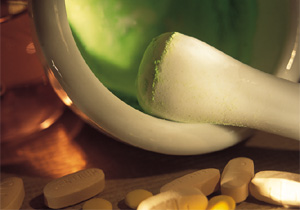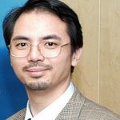Materia Medica - Important
Disclaimer
The information that is available at or
through this site is not intended directly
or by implication to either diagnose or
treat any medical, emotional, or
psychological condition or disorder. It
is always recommended that consultation
with local health care providers be
obtained for specific health or medical
concerns.
Pharmaceutical Name

Rhizoma Dioscoreae
Botanical Name

Dioscorea opposita Thunb.
Common Name

Chinese yam, Dioscorea
Source of Earliest Record

Shennong Bencao Jing
Part Used & Method for Pharmaceutical Preparations

The rhizomes are dug in the period of Frost's Descent (eighteenth solar term). After the rough bark has been removed, the rhizomes are cleaned and dried in either the sun or the shade. Then, they are soaked again and cut into slices.
Properties & Taste

Sweet and neutral
Meridians

Spleen, lung and kidney
Functions

1. To strengthen the spleen and stomach; 2. To tonify the lungs and kidneys
Indications & Combinations

1. Weakness of the spleen and stomach manifested as poor appetite, diarrhea and lassitude. Dioscorea (Shanyao) is used with Ginseng (Renshen), White atractylodes (Baizhu) and Poria (Fuling) in the formula Shen Ling Baizhu San.
2. Excessive dampness due to deficiency of the spleen manifested as whitish and dilute leukorrhagia and lassitude. Dioscorea (Shanyao) is used with White atractylodes (Baizhu), Poria (Fuling) and Euryale seed (Qianshi).
3. Excessive dampness transforming into heat manifested as yellow leukorrhea. Dioscorea (Shanyao) is used with Phellodendron bark (Huangbai) and Plantain seed (Cheqianzi) in the formula Yihuang Tang.
4. Leukorrhagia due to deficient kidneys manifested as leukorrhagia and lower back pain. Dioscorea (Shanyao) is used with Dogwood fruit (Shanzhuyu) and Dadder seed (Tusizi).
5. Diabetes manifested as extreme thirst, excessive drinking, excessive food intake, profuse urination and lassitude. Dioscorea (Shanyao) is used with Astragalus root (Huangqi), Trichosanthes root (Tianhuafen), Fresh rehmannia root (Shengdihuang) and Pueraria root (Gegen) in the formula Yuye Tang.
6. Nocturnal emissions due to deficient kidneys. Dioscorea (Shanyao) is used with Dogwood fruit (Shanzhuyu) and Prepared rehmannia root (Shudihuang) in the formula Liuwei Dihuang Wan.
7. Frequent urination due to kidney deficiency. Dioscorea (Shanyao) is used with Bitter cardamom (Yizhiren) and Mantis egg case (Sangpiaoxiao).
8. Chronic cough due to deficient lungs. Dioscorea (Shanyao) is used with Glehnia root (Shashen), Ophiopogon root (Maidong) and Schisandra fruit (Wuweizi).
Dosage

10-30 g; 6-10 g (for powder)
Cautions & Contraindications

This herb is contraindicated during food retention.
Back
to Materia Medica
| 
 This website is published, edited and designed by Raymond Cheng,
and reflects only and only his personal views and opinions in his individual capacity.
The information available at this website is not intended
directly or by implication to either diagnose or treat any
medical, emotional, or psychological condition or disorder.
It is also not intended to create a physician-patient relationship
between you and I or between you and Wyith Institute™ and The Office of Dr Raymond K K Cheng.
The information here is not a substitute for advice and treatment provided
by your physician or by another healthcare professional.
It is always recommended that consultation with local healthcare providers
be obtained for any of your specific health or medical concerns.
Furthermore, any products that can be purchased (yet you can see I don't have much
to sell here) through advertisers' banners or through links to other websites
are not either explicitly or implicitly given any warranty or endorsement
by me, my colleagues, Wyith Institute™ or any of its associated businesses.
This website is published, edited and designed by Raymond Cheng,
and reflects only and only his personal views and opinions in his individual capacity.
The information available at this website is not intended
directly or by implication to either diagnose or treat any
medical, emotional, or psychological condition or disorder.
It is also not intended to create a physician-patient relationship
between you and I or between you and Wyith Institute™ and The Office of Dr Raymond K K Cheng.
The information here is not a substitute for advice and treatment provided
by your physician or by another healthcare professional.
It is always recommended that consultation with local healthcare providers
be obtained for any of your specific health or medical concerns.
Furthermore, any products that can be purchased (yet you can see I don't have much
to sell here) through advertisers' banners or through links to other websites
are not either explicitly or implicitly given any warranty or endorsement
by me, my colleagues, Wyith Institute™ or any of its associated businesses.



 Thank you for visiting this TCM and acupuncture information website.
If you have previously been to this website, you might have
noticed that some of the pages on ancient historical ideas and
holistic thinkings related to Chinese metaphysics are temporarily taken offline.
This is because I will be revamping the whole website and be moving
those information into a new \"Ancient Chinese Culture\" section
so as to reflect a more current perspective on the interpretation
of some of the fundamental concepts as well as to include
some of the latest information in the area.
But if you have just found this website for the very first time, I welcome you again and
wish you could find what you require and, hopefully, you could also be benefitted
from reading the articles I published on this website.
Thank you for visiting this TCM and acupuncture information website.
If you have previously been to this website, you might have
noticed that some of the pages on ancient historical ideas and
holistic thinkings related to Chinese metaphysics are temporarily taken offline.
This is because I will be revamping the whole website and be moving
those information into a new \"Ancient Chinese Culture\" section
so as to reflect a more current perspective on the interpretation
of some of the fundamental concepts as well as to include
some of the latest information in the area.
But if you have just found this website for the very first time, I welcome you again and
wish you could find what you require and, hopefully, you could also be benefitted
from reading the articles I published on this website.